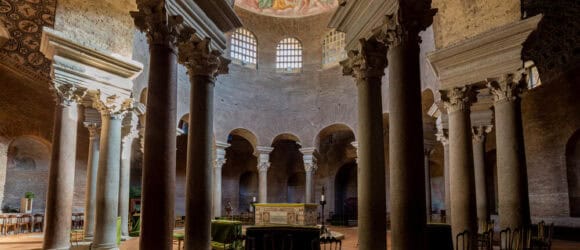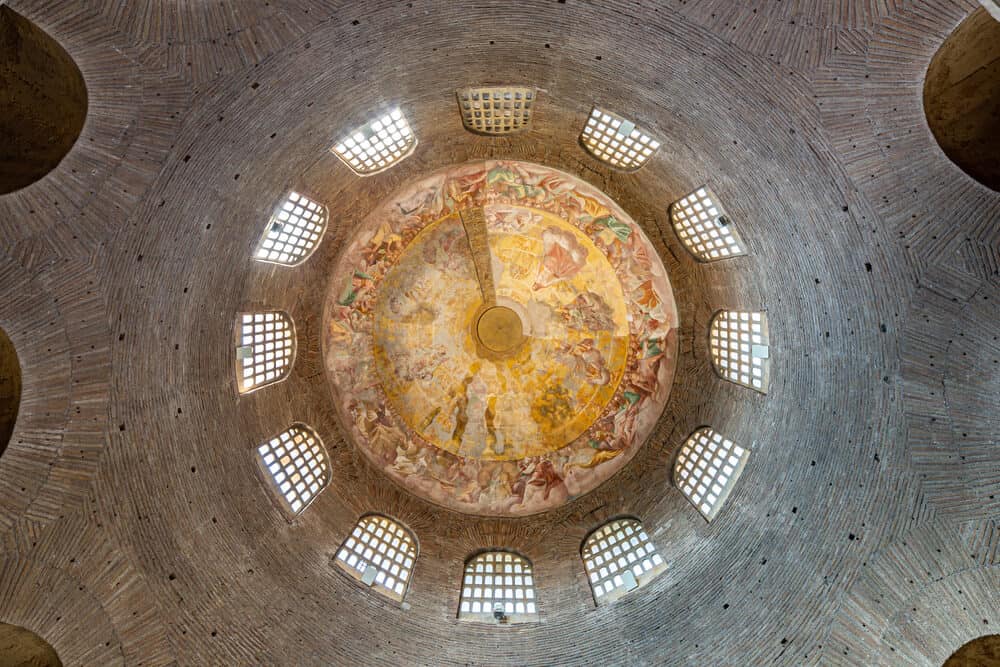Mausoleum of Santa Costanza: Rome’s Hidden Gem of Byzantine Art

The Mausoleum of Santa Costanza in Rome is often regarded as a hidden gem, particularly for those interested in Byzantine art and early Christian architecture. Despite its historical and artistic significance, the Mausoleum of Santa Costanza remains relatively lesser-known than other Roman monuments, making it a peaceful destination for visitors seeking to explore Rome’s history. Here are some reasons this mausoleum deserves a visit when you are in the Eternal City.
Key Facts About the Mausoleum of Santa Costanza
- The Mausoleum of Santa Costanza, built in the 4th century AD as a burial site for Constantina, the daughter of Emperor Constantine the Great, is a hidden gem of early Christian and Byzantine art and architecture. It is known for its elaborate mosaics that blend Christian and pagan symbolism.
- The mausoleum is part of a larger cemetery basilica complex dedicated to Saint Agnes. This reflects the early Christian practice of associating burial sites with places of worship and martyrdom, highlighting the mausoleum’s religious importance.
- The interior mosaics are significant for their depiction of grapevines and harvesting scenes, which symbolize both the pagan god Bacchus and the Christian Eucharist. This illustrates the transitional period in which the mausoleum was built.
- The Vatican Museums house an important artifact from the mausoleum, a red porphyry sarcophagus believed to have been intended for Constantina.
Short History of the Mausoleum of Santa Costanza
The Mausoleum of Santa Costanza was built in the 4th century AD. Although it eventually became the burial site for Constantina, the daughter of Emperor Constantine the Great and his second wife Fausta, it is unclear whether this was the structure’s original purpose.
Constantina was born around 317 AD and was first married to her cousin Hannibalianus, who Constantine appointed to rule over parts of the Eastern Roman Empire. After his death, she married another cousin, Gallus, who was later appointed ruler of the Eastern provinces by Emperor Constantius II, her brother.
Constantina played a significant role in the politics and religious affairs of her time. She is featured in several early medieval martyr narratives. In these stories, she is portrayed as a faithful virgin who, after being cured of leprosy at St. Agnes’ tomb, converted to Christianity and sought permission from her family to build a church and mausoleum.
Constantina died in 354 AD and was buried in the mausoleum.
Constantina’s legacy lives on through the mausoleum and the fact that she was venerated as a saint in the Middle Ages. In the 13th century, during the time of Pope Alexander IV, the mausoleum was officially consecrated as a church dedicated to Santa Costanza.
The Importance of the Location of the Mausoleum
The Mausoleum of Santa Costanza was integrated into the cemetery basilica complex dedicated to Saint Agnes. The mausoleum’s proximity to the basilica shows the connection between Constantina and Saint Agnes, and it reflects the early Christian practice of associating burial sites with places of worship.
The Mausoleum as Early Christian Art
The Mausoleum of Santa Costanza is known not only for being Constantina’s burial place but also as a fine example of early Christian and Byzantine architecture.
The structure was designed with a standard circular plan for Roman imperial mausoleums. It features a central dome surrounded by a walkway, which is separated by twelve pairs of granite columns supporting arches.
The interior is adorned with elaborate ancient mosaics that blend Christian images and pagan symbols. The most prominent scenes depict grape vines intertwined with figures harvesting grapes. These images evoke the pagan god Bacchus, the Roman deity of wine and festivity. On the other hand, the images are also seen as Christian symbols, representing the blood of Christ. There are also Biblical scenes, including those representing St. Peter and St. Paul.
The Vatican Museums house an important artifact from the Mausoleum of Santa Costanza: a large porphyry sarcophagus believed to have been initially intended for Constantina. The sarcophagus is made of red porphyry, a material reserved for imperial use due to its rarity and association with power. The intricate carvings on the sarcophagus depict scenes of cherubs harvesting grapes and making wine, which ties into the mosaic themes of the mausoleum itself.
The presence of this sarcophagus in a Vatican Museum highlights the importance of Constantina and her mausoleum in early Christian history.
Modern Private Mausoleums
The choice of a burial place is important. A private family mausoleum gives your family control over the placement and design of your final resting place. To ensure that your mausoleum is designed and built to your exact wishes and specifications, request a consultation with Eternal Mausoleums by Forever Legacy.

